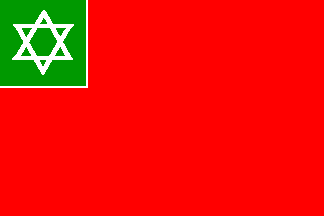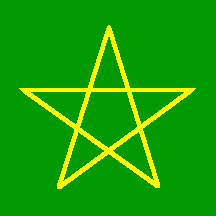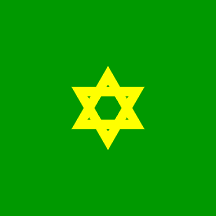
Last modified: 2007-06-09 by antónio martins
Keywords: solomon seal | magen david | caliph | vizir | protectorate | star: 6 points (yellow) | star: 6 points (black) | star: 5 points (yellow) | star: 5 points (white) | makhzen | error | doubt |
Links: FOTW homepage |
search |
disclaimer and copyright |
write us |
mirrors
Merchant Flag (1937-1956)

In the end of the XIXth century, there were a lot of revolts in Morocco
and the European powers decided to solve the “Moroccan problem”.
France occupied Ujda and Casablanca in 1907,
whereas Spain occupied Salwan and other strategic
places in 1909. In spite of German protest, the French
Protectorate over Morocco was established on 30 March 1912. The Sultan
kept a nominal sovereignty. The Spanish zone was
completely autonomous (treaty from 27 November 1912).
Independance of Morocco was accepted by France
on 6 November 1955 and officialized on 2 March 1956, when King Muhammad V
came back from exile. Spain gave back the Rif area to Morocco on 7 April
1956 and the port of Ifni in June 1969.
Ivan Sache, 15 Jun 2003, based on
[lux01]
Some Moroccan provinces
were under Spanish protectorate until 1956. These are
Al Hoceima,
(Che-)Chaouen,
Nador,
Tetouan,
Larache,
and parts of Kenitra,
Taounate,
Taza
and Tiznit
(the Sidi Ifni enclave). (I believe
Laayoune is the old
Spanish Aaiun).
Santiago Dotor, 12 Jan 1999
In Neubecker’s Flaggenbuch
[neu92] the
Merchant Flag of the Spanish Zone is a red flag
with white fimbriated green canton containing a
white pentagram in the middle (ratio: 2:3). The
canton is hlaf the hoist high, and the pentagram
is in relative the same ratio to it as in the
(current) national flag, i.e. inscribed
in circle 1/3 of the canton height.
Željko Heimer, 12 Jun 2002
The original legislation establishing the civil ensign for the Spanish protectorate of Morocco is a Dahir (a Decree signed by the Khaliph i.e. the Sultan’s lieutenant) dated 7th January 1937 regarding the «Nationality of vessels and creation of the ensign for the merchant navy in the zone». Article 3 reads (my translation from original Spanish text):
Vessels registered in the Spanish Zone of Morocco shall fly, when they meet a ship of the [Spanish] State, or when at port, if required by the appropriate authority, the Ensign of the Merchant Navy of this Spanish Zone of Morocco.
Such ensign shall be made up of a red flag defaced on the top part and hoist side with a rectangle depicting the flag commonly used by our Khaliphian House, that is, a natural green [sic] colour rectangle bearing on its centre the five-pointed seal of Solomon in white. The diameter of the imaginary circle circumscrbing the seal of Solomon shall equal one third of the height of the green rectangle, which in turn shall be the same as a quarter of the Ensign [area]. Such rectangle shall be bordered by a white braid of 1/2 centimetre wide, the lines making up the seal of Solomon being three to five centimetres wide depending on the size of the flag.
No vessel may fly this ensign if it does not possess the Khaliphian Merchant Navigation Patent or is not registered in some of the regional maritime districts of this Zone.
The Ensign of the khaliphian merchant navy shall be flown from the stern of the vessels.
Santiago Dotor, 18 Sep 2003
1937 was the adoption date. However
the protectorate was established in 1912.
Santiago Dotor, 05 Apr 2000
According to Flaggenbuch,
the fimbriation around the canton is white. Canton, fimbriation included,
is 1/2th of the flag. Star diameter is 1/3rd of the canton height,
fimbriation included. (No national flag mentioned.)
Ivan Sache, 05 Dec 2000

The image of the flag of the Spanish Occupation zone in
Morocco in the book of K. A. Ivanov, Drapeaux marocains
[ivaXX] is red with a green
canton with in the canton the pentagram in yellow. I
have a written description of this flag where the pentagram is
said to be white, also the fimbration of
the canton is not mentioned.
Harald Müller, 14 Jun 1996

According to Lux-Wurm’s book [lux01],
in the Spanish zone the civil ensign was red with a square green canton
charged with a white Magen David.
Ivan Sache, 15 Jun 2003

1926 Flaggenbuch 1934 correction
[d9e34a] shows a square
red flag as
national and merchant flag of the Spanish zone — no trace yet of
the green canton with white pentagram, which supports the theory that
the latter flag was adopted in 1937.
Santiago Dotor, 18 Jun 2003
The 1926 Flaggenbuch [d9e26]
copy from München City Library does include two flags for Marocco
— the national flag (the usual red with green
pentagram) and the ensign for the French
zone. I can’t say how much corrections are included (and
performed) in the München library copy (certainly on some pages traces
of sticking small pieces of correction patches are noticable), but the
only two flags for Marocco seems to indicate a stage between the original
1926 edition and 1934 correction.
Željko Heimer, 18 Jun 2003

I vaguely remember a flag for the Spanish possessions in Northern
Africa: identical in design to the Moroccan flag,
but colours white pentagram on dark green.
Harald Müller, 12 Feb 1996
According to Lux-Wurm’s book [lux01],
the “Royal standard” was a green square flag with a yellow
pentagram. I can’t figure out which King would have used such a flag.
There was no King in Morocco at the time and I cannot imagine the
King of Spain using such a flag when in
Morocco.
However, both Calvo & Grávalos [cag83]
and Neubecker [neu92] reported the
Kaliph’s flag as a green square flag with a yellow Magen
David.
Therefore, I believe that Lux-Wurm [lux01]
either mixed things up or used erroneous sources.
Ivan Sache, 15 Jun 2003
Such “royal standard” is most probably a mistaken version of the
Caliph’s standard.
Santiago Dotor, 17 Jun 2003

In Neubecker’s Flaggenbuch
[neu92] the
Caliph’s Standard is a green square flag
with yellow hexagram (ratio: 1:1).
Željko Heimer, 12 Jun 2002
Flag of the Khaliph of the Spanish Protectorate of Morocco, which can be seen in Calvo and Grávalos [cag83]. This was used from 1945 (Reglamento de Banderas, Insignias y Distintivos of 11th October 1945) till the independence of Morocco, 28th March 1956. It is described as «a square flag, green with the Makhzen emblem in yellow». The so-called Makhzen sign happens to be an outlined six-pointed star. Though the star is reminiscent of the shield of David, the word Makhzen has nothing to do with magen or mogen (Hebrew for shield). The Makhzen is the name given in Morocco to the central administration together with the Sultan’s governmental suite.
The Arabic term khaliph (deputy) is used here in its strict sense and has nothing to do with the supreme imam of the Muslim community (khalifah rasul Allah or deputy of the messenger of God), a title held by the Ottoman sultans up to this century. During the Spanish protectorate, the Khaliph acted as supreme authority as the Sultan’s deputy, under the control of the Spanish High Commissioner.
Santiago Dotor, 25 Sep 1998
The original edition of Flaggenbuch 1926
[d9e26] showed no flags for Morocco.
Correction no. 329 [d9e34a], issued
1st December 1934, shows several flags for the French
and Spanish zones. The sultan’s standard is
not shown but the kaliph’s
(and the vizier’s) standard certainly is, which implies
that the two latter were adopted in the early 1930s (if not before).
Santiago Dotor, 18 Jun 2003

I am not sure what are the differences between the image from
Flaggenbuch [neu92] and the one
from Calvo and Grávalos [cag83]. I realise
that [cag83] has a too large hexagram
— according to the 1945 regulation, its width should be a third of the
flag’s side. Also, the width of the yellow lines making up the hexagram
should be 1/25th of the flag’s side.
Santiago Dotor, 13 Jun 2002
This regulation just can’t be right: it produces a
too thick hexagram, nothing like the images in Flaggenbuch
[neu92] nor in the law quoted by
Calvo and Grávalos [cag83]!
I assume that there may be some typo, and that width of the yellow
stripes is maybe 1/25 of "c" (i.e., 1/3×1/25 of
hoist) which makes an image much more similar to images in the two
sources.
Željko Heimer, 13 Jun 2002

In Neubecker’s Flaggenbuch
[neu92] the
Grand Vezir’s Standard is a red square
flag with black hexagram (i.e., same as
the Caliph’s flag,
but in different colours; ratio: 1:1).
Željko Heimer, 12 Jun 2002
Anything below this line was not added by the editor of this page.